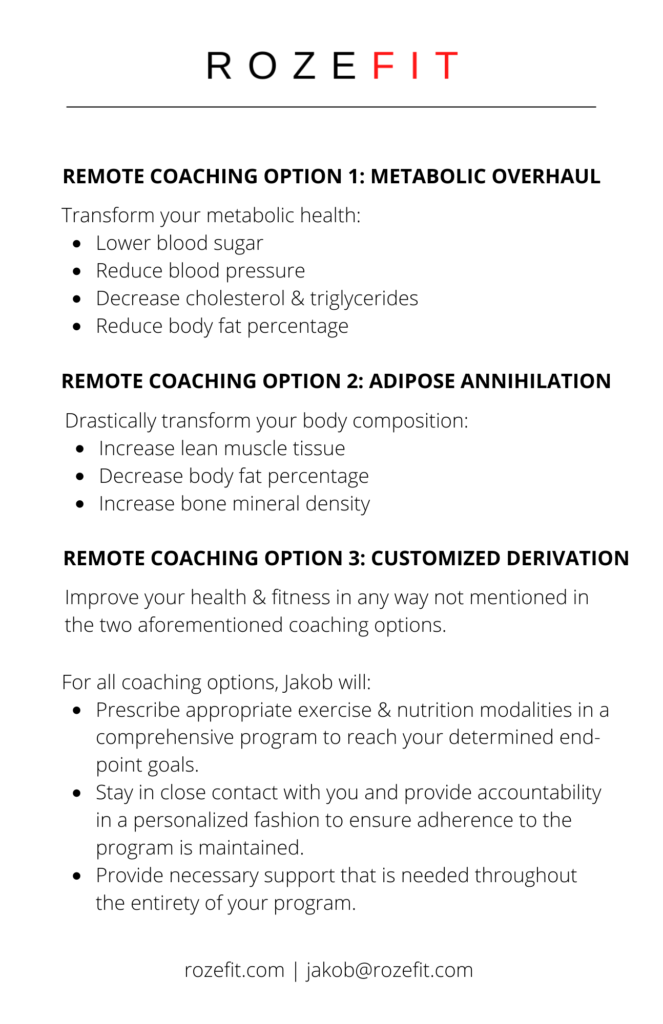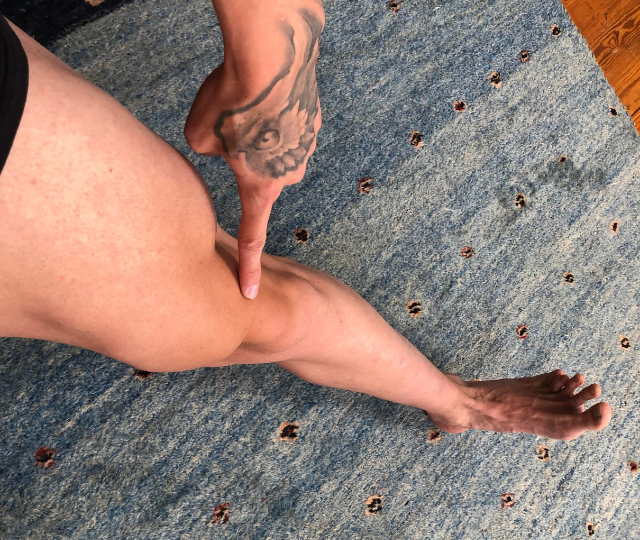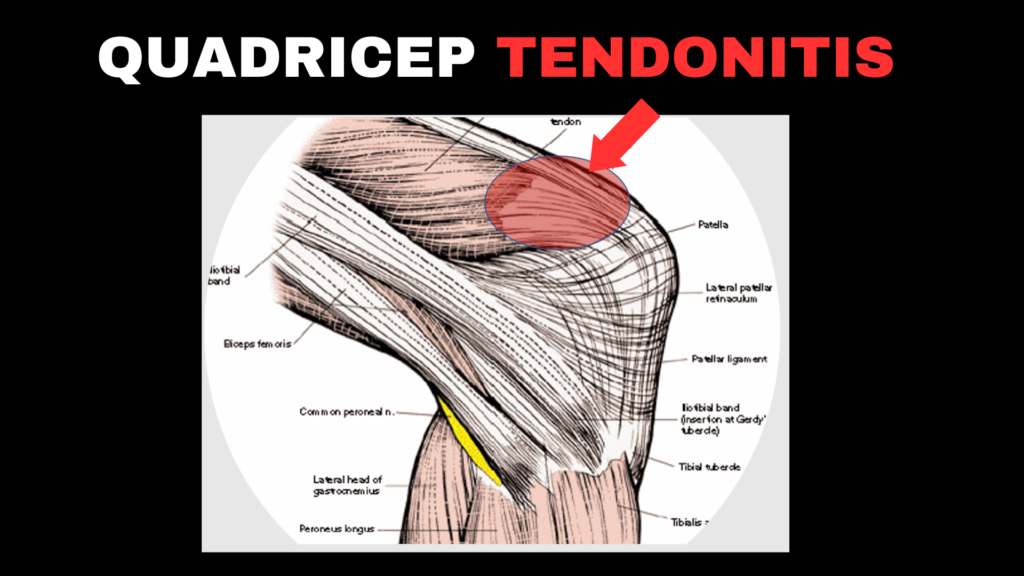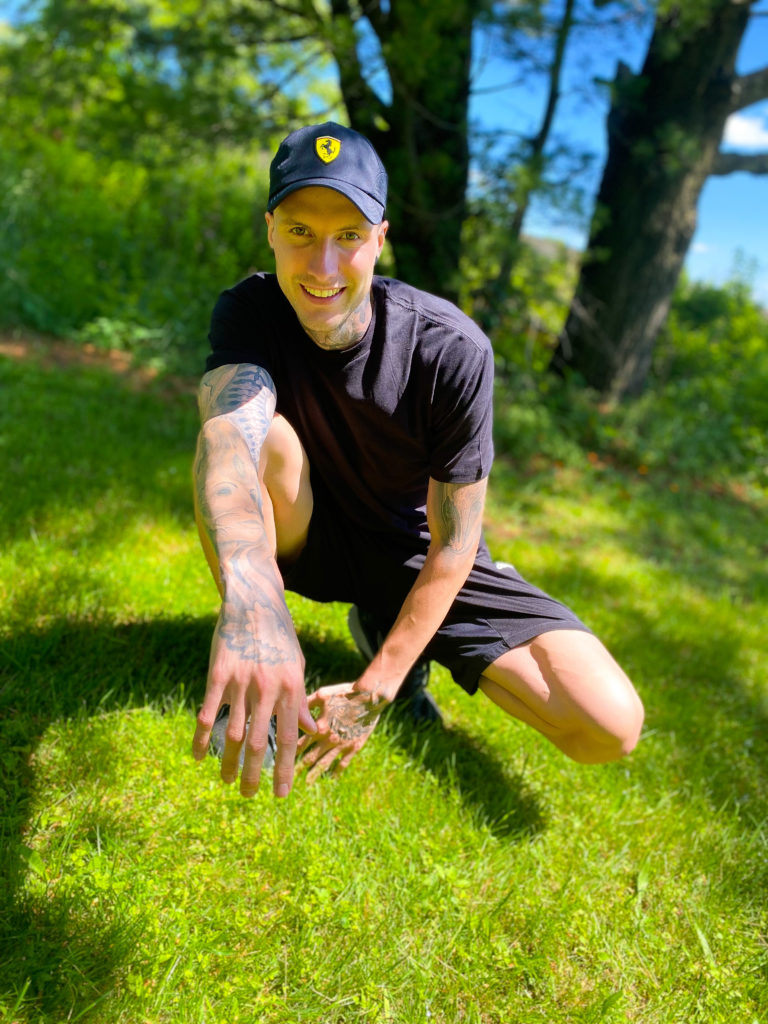Quad tendonitis can best be defined as inflammation of the tendon.
The quadricep tendon attaches from your quadricep to your kneecap.
If the tendon becomes inflamed, you will most likely notice localized pain right above the kneecap or experience the pain as generalized throughout the front of the knee.
I highly recommend hiring a professional if you are having knee pain.
A lot of times, knee pain can result from an overuse injury or being overweight.
I help my clients improve their metabolic health through comprehensive coaching programs.
We can work on your knee pain and other health complications together, take a look below.

Tendinopathy
Once the tendonitis becomes chronic, it is considered ‘tendinopathy.’
It is important to understand that your body is feeling pain because it is trying to send you a message.
It’s saying – “don’t continue to move into that painful range, something important is happening here.”
You can think of the pain as a warning signal.
One that is created in the brain by a neuro-sensory feedback mechanism that protects you from danger.
You see, pain is in the brain, not necessarily in the tissue.
Often pain will occur without any tissue damage at all!
Or even after the affected tissue has healed.
With regards to your knee tendonitis, it is important to understand that the goal is not necessarily to fix the tissue but rather change the signal to the brain that your body is in danger.
In this article we will explore the causes of quadricep tendonitis and what you can do about it to treat that nagging pain!
What Does Tendonitis in the Quad Feel Like?
Often the tendonitis in the quad will be experienced as a dull to sharp ache right above the knee cap.
This is where the quad is attached to the knee.

The pain can be referred upstream or downstream from this site however – more often than not, it will feel localized.
You may experience some swelling and stiffness as well.
A classic tell tale sign of the tendonitis is a cracking sound accompanied with a grinding sensation right above the knee cap.
If you flex or extend the knee, you will often hear a crack or experience a grinding sensation, but not always!
You may also notice changes in your range of motion on the affected side and generalized tenderness of the knee.
The pain can often be reproduced by flexing the knee under the load of your body weight.
In other words, squatting down or lunging.
What Is the Cause of Knee Tendonitis?

Simply put, the tendon was loaded too fast, too soon, and or too much.
Tendonitis is classically described as an ‘overuse’ injury.
In other words, the tendon was unable to keep up with the demand that you placed on it.
Tendons serve the purpose of absorbing and distributing the force that is placed on them.
In essence, tendons protect the joint and allow you to move the joint (i.e. the knee in this case).
From either chronic overloading or an acute overload, the tendon becomes inflamed in order to protect the joint from excessive load.
Sometimes however, the load may not have felt excessive at all.
For example, if you were going for a leisurely hike one day and all of a sudden – the next morning you wake up and have pain above the knee cap.

You ask yourself – how the heck did that happen?
Often the demand that our body recognizes, does not match the subjective feeling of exertion that you may experience.
In other words, you can develop quad tendonitis without ever ‘feeling’ like you overdid it.
Other times, the issue may stem from chronic overloading.
Pushing the tendon beyond capacity, just in the slightest.
This then compounds over time and one day you wake up and have pain above the knee cap.
Think of your tendon having a load tolerance set point.
Exceed the set point, and the result is inflammation.
Pain is an incredibly multifaceted process that involves as much of the brain as it does the actual tissue.
Be sure to check out this article I wrote if you want to learn more about pain science!
Another Often Missed Root Cause of Quadricep Tendonitis
Besides overloading, often the tendonitis can be caused by maltracking of the patella.
The patella sits in a groove called the femoral groove and each time the knee flexes or extends, the patella needs to track within this groove.
If the muscles surrounding the tendon are tight or inflamed, it can cause the patella to track outside of its normal groove.
It grinds against the sides of the groove causing irritation to the underside of the knee cap.

Furthermore, if the femur (thigh bone) and tibia (shin bone) do not align properly, this can also cause unequal vector forces to be placed on the knee.
This results in excessive stress placed on the quad tendon leading to inflammation and pain.
We will discuss all of the treatments for these possible root causes below!
Does Quadriceps Tendonitis Go Away and How Long Does It Take to heal?
Although it may feel like the pain from your quad tendonitis is taking forever to go away, I promise you it will go away.
You just have to take the correct steps to rehabbing your knee!
I don’t like to put a time frame on things like this because everyone is different.
At the very least expect several weeks to rehab yourself back to full function.
I am confident that you can reclaim your function and you should be too!
By following this protocol, you should experience relief from your knee pain and quad tendonitis/tendinopathy.
How Do You Treat Quad Tendonitis?
In order to fix your knee pain and quad tendonitis, you need to have a plan of action.
Follow this three step process.
1.) First, you will reduce the inflammation.
2.) Second, you will improve the sliding surfaces of the soft tissue around the joint.
3.) Third, you will address any mobility issues and begin strengthening the tendon.
Hire a Coach

I highly recommend hiring a coach if you need help addressing your knee pain.
I’ve helped hundreds of clients address their pain, body weight, and overall metabolic health through carefully crafted exercise & diet prescriptions.
Quad Tendonitis Treatment Exercises
Now that we have discussed the causes of quad tendonitis, we can dive into the exercises which will treat your pain!
First and foremost, it is important to be patient.
These exercises will not fix your issue overnight but by methodically following the steps below, you will be able to rehab your knee pain.
Each of the three steps below is accompanied with an in depth explanation video that takes you through the process in great detail, so be sure to watch it – in addition to the written instructions!
Step One: Reduce the Inflammation
You’ve heard it before and there is a reason for that!
You absolutely need to reduce some of the inflammation before you can rehab the tendon back to full strength.
If you continue to place the same demands on your tendon that is causing the tendonitis in the first place, then you will simply continue to feel pain.
You need to change something and here’s your first opportunity to do so.
By halting the activities that are causing you to feel pain, you have already taken the first steps to a pain free knee.
Simply stop doing any of the activities that bring about the pain!
If you are cycling and it causes the pain, stop it.
If you do a lunge and it hurts, stop it.
If you are doing any exercise or movement that brings about the pain, you need to temporarily stop it.
In order to expedite lowering the inflammation, I want you to ice your knee.
Specifically, I want you to ice where you feel the point tenderness using a localized approach with a single ice cube.
You are going to take the ice cube and rub it over the area. You are going to ice your knee like this 3 times a day for 1 week.
See the video demonstration below.
Step Two: Improve the Sliding Surfaces
It is imperative that you go through step one before going through step two.
If the inflammation has not subsided at least a little, you will not benefit from step two and it could make the issue worse!
After you have reduced some of the inflammation, you need to begin improving the sliding surfaces surrounding the knee cap.
When inflammation occurs, the fascia which surrounds your muscles gets stiff.
In order to get those surfaces sliding better again, you are going to foam roll the quad.
This will send a neurological signal to those muscles to relax a little and it will get the fascia functioning better.
Ultimately, down-regulating those pain signals that you are experiencing.
After you foam roll the quad for a few minutes, you will use a band and tack down the tissues above and below the knee and move through an active range of motion.
This will ultimately stretch the tissues out and improve function of the knee.
The last tactic you will use in this section involves taking the back of a butter knife and using it to rub the area above the knee cap, right at that quad insertion.
Often what happens with quad tendonitis is that the collagen fibers which make up the tissue get misaligned as they are laid down to repair the tendon.
This is often called scar tissue but it is a bit of a misnomer.
In order to get those collagen fibers to lay down properly again, you need to break up the malformed adhesions that have started to develop.
This will also help bring blood to the healing tendon as tendons receive little blood supply and thereby take longer to heal.
You can speed up the process by bringing blood there manually.
You are going to use some sort of lubricant and rub the area until it gets red.
5 minutes or so.
Step Three: Strengthen
Now what? It’s time to strengthen.
You need to begin reintroducing load to the tendon in order to strengthen it.
The first step will be to isometrically load the quad.
In other words, create a muscular contraction without movement.
Perform a wall sit by bending the knee to about 60 degrees or right above the range of motion that provokes your pain.
Hold this position for 45 seconds to a minute if you can.
If it is too easy, move on to doing it single legged. It should be challenging but not painful.
This first step of isometric loading will downregulate pain signaling via cortical inhibition and also begin to strengthen the tendon which has become weak.
Perform this isometric exercise 3x per day for 1 week.
You should start feeling some pain relief.
At this point you need to introduce more stimulus to create adaptations in the tendon.
Once you can perform a bodyweight squat again without pain, it is time to start loading this movement.
Begin by performing a body weight squat at a slow tempo 3:1:3 for 1 week.
Perform 3 sets of 10 repetitions 3 times a day.
Then gradually increase the demand of the movement by holding a weight in your hand.
Always check in to make sure that your pain is not getting worse again.
If it is, back off again and slowly work back into it.
As you reintroduce load to the tendon, it will begin to adapt and get stronger again to withstand the demands you place on it.
However, it is really important that you reintroduce load SLOWLY.
You need to start with body weight exercises and do not push into painful ranges.
In other words, if you don’t have pain squatting down to 45 degrees but then it hurts at 90 degrees – stop at 45!
If it is painful, it is your body’s way of saying ‘i’m not ready yet.’
Start with simple body weight exercises like a squat or lunge and then gradually introduce more and more load stimulus over time.
As you strengthen the tendon, it will be able to tolerate the new stimulus and this adaptation will keep you pain free!
Reach Out to Me for More Help
Send me an email and I’d be happy to help you with a solution to your knee pain!
You can contact me at jakob@rozefit.com

